Smart Waste Management and Classification Systems Using Cutting Edge Approach
Abstract
:1. Introduction
- We combine IoT and deep learning paradigms to ensure an optimal solution for waste management.
- We design a waste classification model (WCM) that classifies the waste into biodegradable and non-biodegradable items, such as plastic, metal, glass, etc., using the image classification technique.
- We implement an architectural development process of smart waste dump using the segmented grid image captured by a camera mounted on the raspberry pie.
- We develop a smart way to monitor the waste dump in real time using a cutting-edge approach that decreases the overall latency and improves energy utilization.
- We combine the cloud and edge processing mechanism as a hybrid computing phenomenon which improves the overall performance of the proposed system.
- We perform a performance analysis of the proposed system results.
2. Literature Review
3. Proposed Methodology
3.1. Edge Node Processing
3.1.1. Image Capture
3.1.2. Grid Segmentation
- Phase 1: In the first step, we map the captured image of a waste dump on a grid-like cell structure, i.e., 5 × 6 matrix, of the same resolutions, and convert it into grayscale. The size of the grid and the total number of cells depend on the test image size.
- Phase 2: In the second step, initial classification is performed, and labels are applied based on the texture, color, and position features of each segment by the VGG-16 algorithm as dicussed in Section 3.3.2. Each cell segment is processed separately to recognize the waste items appropriately. After that, we move from one segment to another column-wise to the VGG16 algorithm to recognize the waste item effectively. Each cell contains one waste object at a time, which is ultimately picked by the robotic arm and placed in a respective bin. This process continues until the whole test image has been processed. Incorrect segments are put back, and final labeling or classification consists of the union of only correct segments.
3.1.3. Waste Item Classification
3.2. Control Unit
3.3. Cloud Processing
3.3.1. Data Storage
3.3.2. Deep Learning Algorithm
4. Experimental Setup
4.1. Dataset Description
4.2. Performance Metrics
4.2.1. Accuracy
4.2.2. Latency Overhead
4.2.3. Resource Energy Utilization
4.3. Performance Analysis
Accuracy Comparison
4.4. System Latency Comparison
4.5. Error Rate Comparison
4.6. Inference Time Comparison
4.7. Average Precision Comparison
4.8. Resource Utilization Comparison
5. Critical Analysis
Test Predictions
6. Conclusions
Author Contributions
Funding
Institutional Review Board Statement
Informed Consent Statement
Data Availability Statement
Acknowledgments
Conflicts of Interest
References
- Pires, I.; Souza, G.; Junior, J. An Analysis of the Relation between Garbage Pickers and Women’s Health Risk. Acta Sci. Agric. 2020, 4, 12–16. [Google Scholar]
- Liu, J.; Balatti, P.; Ellis, K.; Hadjivelichkov, D.; Stoyanov, D.; Ajoudani, A.; Kanoulas, D. Garbage collection and sorting with a mobile manipulator using deep learning and whole-body control. In Proceedings of the 2020 IEEE-RAS 20th International Conference on Humanoid Robots (Humanoids), Munich, Germany, 19–21 July 2021; pp. 408–414. [Google Scholar]
- Waste Management Indicators. Available online: https://ec.europa.eu/eurostat/statistics-explained/index.php?title=Waste_management_indicators (accessed on 5 July 2022).
- Lagakos, D. Urban-rural gaps in the developing world: Does internal migration offer opportunities? J. Econ. Perspect. 2020, 34, 174–192. [Google Scholar] [CrossRef]
- Nañez Alonso, S.L.; Reier Forradellas, R.F.; Pi Morell, O.; Jorge-Vazquez, J. Digitalization, circular economy and environmental sustainability: The application of Artificial Intelligence in the efficient self-management of waste. Sustainability 2021, 13, 2092. [Google Scholar] [CrossRef]
- Bagri, V.; Sharma, L.; Patil, B.; Dhage, S.N. Survey of Automated Waste Segregation Methods. In Advances in Computer, Communication and Computational Sciences; Springer: Berlin/Heidelberg, Germany, 2021; pp. 953–964. [Google Scholar]
- Zhang, Q.; Zhang, X.; Mu, X.; Wang, Z.; Tian, R.; Wang, X.; Liu, X. Recyclable waste image recognition based on deep learning. Resour. Conserv. Recycl. 2021, 171, 105636. [Google Scholar] [CrossRef]
- Rahman, M.W.; Islam, R.; Hasan, A.; Bithi, N.I.; Hasan, M.M.; Rahman, M.M. Intelligent waste management system using deep learning with IoT. J. King Saud Univ.-Comput. Inf. Sci. 2020, 34, 2072–2087. [Google Scholar] [CrossRef]
- Ramsurrun, N.; Suddul, G.; Armoogum, S.; Foogooa, R. Recyclable Waste Classification Using Computer Vision And Deep Learning. In Proceedings of the 2021 Zooming Innovation in Consumer Technologies Conference (ZINC), Novi Sad, Serbia, 26–27 May 2021; pp. 11–15. [Google Scholar]
- Mao, W.L.; Chen, W.C.; Wang, C.T.; Lin, Y.H. Recycling waste classification using optimized convolutional neural network. Resour. Conserv. Recycl. 2021, 164, 105132. [Google Scholar] [CrossRef]
- Altikat, A.; Gulbe, A.; Altikat, S. Intelligent solid waste classification using deep convolutional neural networks. Int. J. Environ. Sci. Technol. 2022, 19, 1285–1292. [Google Scholar] [CrossRef]
- The FUSON Website. Available online: https://www.fuzon.io/insight/top-iotstatistics/ (accessed on 5 July 2022).
- The STATISTA Website. Available online: https://www.statista.com/topics/2637/internet-of-things/ (accessed on 5 July 2022).
- Sheng, T.J.; Islam, M.S.; Misran, N.; Baharuddin, M.H.; Arshad, H.; Islam, M.R.; Chowdhury, M.E.; Rmili, H.; Islam, M.T. An internet of things based smart waste management system using LoRa and tensorflow deep learning model. IEEE Access 2020, 8, 148793–148811. [Google Scholar] [CrossRef]
- Esmaeilian, B.; Wang, B.; Lewis, K.; Duarte, F.; Ratti, C.; Behdad, S. The future of waste management in smart and sustainable cities: A review and concept paper. Waste Manag. 2018, 81, 177–195. [Google Scholar] [CrossRef]
- Catarinucci, L.; Colella, R.; Consalvo, S.I.; Patrono, L.; Rollo, C.; Sergi, I. IoT-aware waste management system based on cloud services and ultra-low-power RFID sensor-tags. IEEE Sens. J. 2020, 20, 14873–14881. [Google Scholar] [CrossRef]
- Livani, E.; Nguyen, R.; Denzinger, J.; Ruhe, G.; Banack, S. A hybrid machine learning method and its application in municipal waste prediction. In Industrial Conference on Data Mining; Springer: Berlin/Heidelberg, Germany, 2013; pp. 166–180. [Google Scholar]
- Yigitcanlar, T.; Cugurullo, F. The sustainability of artificial intelligence: An urbanistic viewpoint from the lens of smart and sustainable cities. Sustainability 2020, 12, 8548. [Google Scholar] [CrossRef]
- Belli, L.; Cilfone, A.; Davoli, L.; Ferrari, G.; Adorni, P.; Di Nocera, F.; Dall’Olio, A.; Pellegrini, C.; Mordacci, M.; Bertolotti, E. IoT-enabled smart sustainable cities: Challenges and approaches. Smart Cities 2020, 3, 1039–1071. [Google Scholar] [CrossRef]
- Davis, D.R.; Dingel, J.I. A spatial knowledge economy. Am. Econ. Rev. 2019, 109, 153–170. [Google Scholar] [CrossRef]
- Davis, D.R.; Dingel, J.I. The comparative advantage of cities. J. Int. Econ. 2020, 123, 103291. [Google Scholar] [CrossRef]
- Klimanova, O.; Illarionova, O.; Grunewald, K.; Bukvareva, E. Green infrastructure, urbanization, and ecosystem services: The main challenges for Russia’s largest cities. Land 2021, 10, 1292. [Google Scholar] [CrossRef]
- Kuddus, M.A.; Tynan, E.; McBryde, E. Urbanization: A problem for the rich and the poor? Public Health Rev. 2020, 41, 1–4. [Google Scholar] [CrossRef]
- Anierobi, C.; Obasi, C.O. Urbanization and Rural-Urban Migration: Toward Involving the Church in Addressing Pro-Poor Urban Housing Challenges in Enugu, Nigeria. SAGE Open 2021, 11, 21582440211040123. [Google Scholar] [CrossRef]
- Blair, J.; Mataraarachchi, S. A Review of Landfills, Waste and the Nearly Forgotten Nexus with Climate Change. Environments 2021, 8, 73. [Google Scholar] [CrossRef]
- Wang, Y.S. The challenges and strategies of food security under rapid urbanization in China. Sustainability 2019, 11, 542. [Google Scholar] [CrossRef]
- Arfanuzzaman, M.; Dahiya, B. Sustainable urbanization in Southeast Asia and beyond: Challenges of population growth, land use change, and environmental health. Growth Chang. 2019, 50, 725–744. [Google Scholar] [CrossRef]
- Ravichandran, C.; Venkatesan, G. Toward sustainable solid waste management–challenges and opportunities. Handb. Adv. Approaches Towards Pollut. Prev. Control 2021, 2, 67–103. [Google Scholar]
- Niinimäki, K.; Peters, G.; Dahlbo, H.; Perry, P.; Rissanen, T.; Gwilt, A. The environmental price of fast fashion. Nat. Rev. Earth Environ. 2020, 1, 189–200. [Google Scholar] [CrossRef]
- Rahimi, A.; García, J.M. Chemical recycling of waste plastics for new materials production. Nat. Rev. Chem. 2017, 1, 1–11. [Google Scholar] [CrossRef]
- Gelan, E. Municipal Solid waste management practices for achieving green architecture concepts in Addis Ababa, Ethiopia. Technologies 2021, 9, 48. [Google Scholar] [CrossRef]
- Abuga, D.; Raghava, N. Real-time smart garbage bin mechanism for solid waste management in smart cities. Sustain. Cities Soc. 2021, 75, 103347. [Google Scholar] [CrossRef]
- Srivastav, A.L.; Kumar, A. An endeavor to achieve sustainable development goals through floral waste management: A short review. J. Clean. Prod. 2021, 283, 124669. [Google Scholar] [CrossRef]
- Wen, Z.; Xie, Y.; Chen, M.; Dinga, C.D. China’s plastic import ban increases prospects of environmental impact mitigation of plastic waste trade flow worldwide. Nat. Commun. 2021, 12, 1–9. [Google Scholar] [CrossRef] [PubMed]
- Lam, S.S.; Alstrup, A.K.; Sonne, C. Denmark recycling plan will cut waste by two-thirds. Nature 2020, 584, 192–193. [Google Scholar] [CrossRef]
- Li, J.; Xiao, F.; Zhang, L.; Amirkhanian, S.N. Life cycle assessment and life cycle cost analysis of recycled solid waste materials in highway pavement: A review. J. Clean. Prod. 2019, 233, 1182–1206. [Google Scholar] [CrossRef]
- Chen, Y.C. Evaluating greenhouse gas emissions and energy recovery from municipal and industrial solid waste using waste-to-energy technology. J. Clean. Prod. 2018, 192, 262–269. [Google Scholar] [CrossRef]
- Abdollahbeigi, M. An overview of the paper recycling process in Iran. J. Chem. Rev. 2020, 3, 1–19. [Google Scholar]
- Radwan, N.; Khan, N.A.; Elmanfaloty, R.A.G. Optimization of solid waste collection using RSM approach, and strategies delivering sustainable development goals (SDG’s) in Jeddah, Saudi Arabia. Sci. Rep. 2021, 11, 1–12. [Google Scholar] [CrossRef] [PubMed]
- Ahmed, Z.; Asghar, M.M.; Malik, M.N.; Nawaz, K. Moving towards a sustainable environment: The dynamic linkage between natural resources, human capital, urbanization, economic growth, and ecological footprint in China. Resour. Policy 2020, 67, 101677. [Google Scholar] [CrossRef]
- Rehman, A.; Khan, K.A.; Hamid, T.; Nasir, H.; Ahmad, I.; Alam, M. Effective utilization of municipal solid waste as substitute for natural resources in cement industry. Civ. Eng. J. 2020, 6, 238–257. [Google Scholar] [CrossRef]
- Sarc, R.; Curtis, A.; Kandlbauer, L.; Khodier, K.; Lorber, K.E.; Pomberger, R. Digitalisation and intelligent robotics in value chain of circular economy oriented waste management—A review. Waste Manag. 2019, 95, 476–492. [Google Scholar] [CrossRef]
- Chen, D.M.C.; Bodirsky, B.L.; Krueger, T.; Mishra, A.; Popp, A. The world’s growing municipal solid waste: Trends and impacts. Environ. Res. Lett. 2020, 15, 074021. [Google Scholar] [CrossRef]
- Glouche, Y.; Couderc, P. A smart waste management with self-describing objects. In Proceedings of the Second International Conference on Smart Systems, Devices and Technologies (SMART’13), Rome, Italy, 23–28 June 2013. [Google Scholar]
- Anagnostopoulos, T.; Zaslavsky, A.; Kolomvatsos, K.; Medvedev, A.; Amirian, P.; Morley, J.; Hadjieftymiades, S. Challenges and opportunities of waste management in IoT-enabled smart cities: A survey. IEEE Trans. Sustain. Comput. 2017, 2, 275–289. [Google Scholar] [CrossRef]
- Omara, A.; Gulen, D.; Kantarci, B.; Oktug, S.F. Trajectory-assisted municipal agent mobility: A sensor-driven smart waste management system. J. Sens. Actuator Netw. 2018, 7, 29. [Google Scholar] [CrossRef]
- Cai, X.; Niu, Y.; Geng, S.; Zhang, J.; Cui, Z.; Li, J.; Chen, J. An under-sampled software defect prediction method based on hybrid multi-objective cuckoo search. Concurr. Comput. Pract. Exp. 2020, 32, e5478. [Google Scholar] [CrossRef]
- Yang, M.; Thung, G. Classification of trash for recyclability status. CS229 Proj. Rep. 2016, 2016, 3. [Google Scholar]
- Wang, H. Garbage recognition and classification system based on convolutional neural network VGG16. In Proceedings of the 2020 3rd International Conference on Advanced Electronic Materials, Computers and Software Engineering (AEMCSE), Shenzhen, China, 24–26 April 2020; pp. 252–255. [Google Scholar]
- Cao, L.; Xiang, W. Application of convolutional neural network based on transfer learning for garbage classification. In Proceedings of the 2020 IEEE 5th Information Technology and Mechatronics Engineering Conference (ITOEC), Chongqing, China, 12–14 June 2020; pp. 1032–1036. [Google Scholar]
- Vo, A.H.; Son, L.H.; Vo, M.T.; Le, T. A novel framework for trash classification using deep transfer learning. IEEE Access 2019, 7, 178631–178639. [Google Scholar] [CrossRef]
- Liao, Y. A Web-Based Dataset for Garbage Classification Based on Shanghai’s Rule. Int. J. Mach. Learn. Comput. 2020, 10, 18–24. [Google Scholar] [CrossRef]
- Huang, G.L.; He, J.; Xu, Z.; Huang, G. A combination model based on transfer learning for waste classification. Concurr. Comput. Pract. Exp. 2020, 32, e5751. [Google Scholar] [CrossRef]
- Aral, R.A.; Keskin, Ş.R.; Kaya, M.; Hacıömeroğlu, M. Classification of trashnet dataset based on deep learning models. In Proceedings of the 2018 IEEE International Conference on Big Data (Big Data), Seattle, WA, USA, 10–13 December 2018; pp. 2058–2062. [Google Scholar]
- Rabano, S.L.; Cabatuan, M.K.; Sybingco, E.; Dadios, E.P.; Calilung, E.J. Common garbage classification using mobilenet. In Proceedings of the 2018 IEEE 10th International Conference on Humanoid, Nanotechnology, Information Technology, Communication and Control, Environment and Management (HNICEM), Baguio City, Philippines, 29 November–2 December 2018; pp. 1–4. [Google Scholar]
- Ozkaya, U.; Seyfi, L. Fine-tuning models comparisons on garbage classification for recyclability. arXiv 2019, arXiv:1908.04393. [Google Scholar]
- Sidharth, R.; Rohit, P.; Vishagan, S.; Karthika, R.; Ganesan, M. Deep learning based smart garbage classifier for effective waste management. In Proceedings of the 2020 5th International Conference on Communication and Electronics Systems (ICCES), Coimbatore, India, 10–12 June 2020; pp. 1086–1089. [Google Scholar]
- Adedeji, O.; Wang, Z. Intelligent waste classification system using deep learning convolutional neural network. Procedia Manuf. 2019, 35, 607–612. [Google Scholar] [CrossRef]
- Chu, Y.; Huang, C.; Xie, X.; Tan, B.; Kamal, S.; Xiong, X. Multilayer hybrid deep-learning method for waste classification and recycling. Comput. Intell. Neurosci. 2018, 2018, 5060857. [Google Scholar] [CrossRef]
- Bobulski, J.; Kubanek, M. Waste classification system using image processing and convolutional neural networks. In International Work-Conference on Artificial Neural Networks; Springer: Cham, Switerland, 2019; pp. 350–361. [Google Scholar]
- Srinilta, C.; Kanharattanachai, S. Municipal solid waste segregation with CNN. In Proceedings of the 2019 5th International Conference on Engineering, Applied Sciences and Technology (ICEAST), Luang Prabang, Laos, 2–5 July 2019; pp. 1–4. [Google Scholar]
- Susanth, G.S.; Livingston, L.J.; Livingston, L.A. Garbage Waste Segregation Using Deep Learning Techniques. In IOP Conference Series: Materials Science and Engineering; IOP Publishing: Bristol, UK, 2021; Volume 1012, p. 012040. [Google Scholar]
- Simonyan, K.; Zisserman, A. Very deep convolutional networks for large-scale image recognition. arXiv 2014, arXiv:1409.1556. [Google Scholar]
- Zeiler, M.D.; Fergus, R. Visualizing and understanding convolutional networks. In European Conference on Computer Vision; Springer: Cham, Switerland, 2014; pp. 818–833. [Google Scholar]
- Wang, J.; Yang, Y.; Mao, J.; Huang, Z.; Huang, C.; Xu, W. Cnn-rnn: A unified framework for multi-label image classification. In Proceedings of the IEEE Conference on Computer Vision and Pattern Recognition, Las Vegas, NV, USA, 27–30 June 2016; pp. 2285–2294. [Google Scholar]
- Alsubaei, F.S.; Al-Wesabi, F.N.; Hilal, A.M. Deep Learning-Based Small Object Detection and Classification Model for Garbage Waste Management in Smart Cities and IoT Environment. Appl. Sci. 2022, 12, 2281. [Google Scholar] [CrossRef]
- Akkad, M.Z.; Haidar, S.; Bányai, T. Design of Cyber-Physical Waste Management Systems Focusing on Energy Efficiency and Sustainability. Designs 2022, 6, 39. [Google Scholar] [CrossRef]
- Ijemaru, G.K.; Ang, L.M.; Seng, K.P. Transformation from IoT to IoV for waste management in smart cities. J. Netw. Comput. Appl. 2022, 204, 103393. [Google Scholar] [CrossRef]
- Abdullah, N.; Al-Wesabi, O.A.; Mohammed, B.A.; Al-Mekhlafi, Z.G.; Alazmi, M.; Alsaffar, M.; Anbar, M.; Sumari, P. Integrated Approach to Achieve a Sustainable Organic Waste Management System in Saudi Arabia. Foods 2022, 11, 1214. [Google Scholar] [CrossRef]
- Fawwaz, D.Z.; Chung, S.H.; Ahn, C.W.; Kim, W.S. Optimal Distributed MQTT Broker and Services Placement for SDN-Edge Based Smart City Architecture. Sensors 2022, 22, 3431. [Google Scholar] [CrossRef] [PubMed]
- Namoun, A.; Hussein, B.R.; Tufail, A.; Alrehaili, A.; Syed, T.A.; BenRhouma, O. An Ensemble Learning Based Classification Approach for the Prediction of Household Solid Waste Generation. Sensors 2022, 22, 3506. [Google Scholar] [CrossRef] [PubMed]
- Hussain, A.; Draz, U.; Ali, T.; Tariq, S.; Irfan, M.; Glowacz, A.; Antonino Daviu, J.A.; Yasin, S.; Rahman, S. Waste management and prediction of air pollutants using IoT and machine learning approach. Energies 2020, 13, 3930. [Google Scholar] [CrossRef]
- Shamin, N.; Fathimal, P.M.; Raghavendran, R.; Prakash, K. Smart garbage segregation & management system using Internet of Things (IoT) & Machine Learning (ML). In Proceedings of the 2019 1st International Conference on Innovations in Information and Communication Technology (ICIICT), Chennai, India, 25–26 April 2019; pp. 1–6. [Google Scholar]
- Koyanaka, S.; Kobayashi, K. Automatic sorting of lightweight metal scrap by sensing apparent density and three-dimensional shape. Resour. Conserv. Recycl. 2010, 54, 571–578. [Google Scholar] [CrossRef]
- Koyanaka, S.; Kobayashi, K. Incorporation of neural network analysis into a technique for automatically sorting lightweight metal scrap generated by ELV shredder facilities. Resour. Conserv. Recycl. 2011, 55, 515–523. [Google Scholar] [CrossRef]
- Rahman, M.O.; Hussain, A.; Scavino, E.; Basri, H.; Hannan, M. Intelligent computer vision system for segregating recyclable waste papers. Expert Syst. Appl. 2011, 38, 10398–10407. [Google Scholar] [CrossRef]
- Omar, L.G.; Oscar, R.A.; Andres, T.G.; Francisco, S.G. Multimedia inorganic waste separator. In Proceedings of the 2013 IEEE International Conference on Multimedia and Expo Workshops (ICMEW), San Jose, CA, USA, 15–19 July 2013; pp. 1–4. [Google Scholar]
- Rahman, M.O.; Hussain, A.; Scavino, E.; Hannan, M.; Basri, H. DNA computer based algorithm for recyclable waste paper segregation. Appl. Soft Comput. 2015, 31, 223–240. [Google Scholar] [CrossRef]
- Sakr, G.E.; Mokbel, M.; Darwich, A.; Khneisser, M.N.; Hadi, A. Comparing deep learning and support vector machines for autonomous waste sorting. In Proceedings of the 2016 IEEE International Multidisciplinary Conference on Engineering Technology (IMCET), Beirut, Lebanon, 2–4 November 2016; pp. 207–212. [Google Scholar]
- Zhihong, C.; Hebin, Z.; Yanbo, W.; Binyan, L.; Yu, L. A vision-based robotic grasping system using deep learning for garbage sorting. In Proceedings of the 2017 36th Chinese Control Conference (CCC), Dalian, China, 26–28 July 2017; pp. 11223–11226. [Google Scholar]
- Setiawan, W.; Wahyudin, A.; Widianto, G. The use of scale invariant feature transform (SIFT) algorithms to identification garbage images based on product label. In Proceedings of the 2017 3rd International Conference on Science in Information Technology (ICSITech), Bandung, Indonesia, 25–26 October 2017; pp. 336–341. [Google Scholar]
- Kumar, S.; Yadav, D.; Gupta, H.; Verma, O.P.; Ansari, I.A.; Ahn, C.W. A novel yolov3 algorithm-based deep learning approach for waste segregation: Towards smart waste management. Electronics 2020, 10, 14. [Google Scholar] [CrossRef]
- Yang, Z.; Li, D. Wasnet: A neural network-based garbage collection management system. IEEE Access 2020, 8, 103984–103993. [Google Scholar] [CrossRef]
- Bobulski, J.; Kubanek, M. Deep learning for plastic waste classification system. Appl. Comput. Intell. Soft Comput. 2021, 2021, 6626948. [Google Scholar] [CrossRef]
- Trashnet Waste Categries Dataset Github Link. Available online: https://github.com/garythung/trashnet (accessed on 10 August 2022).
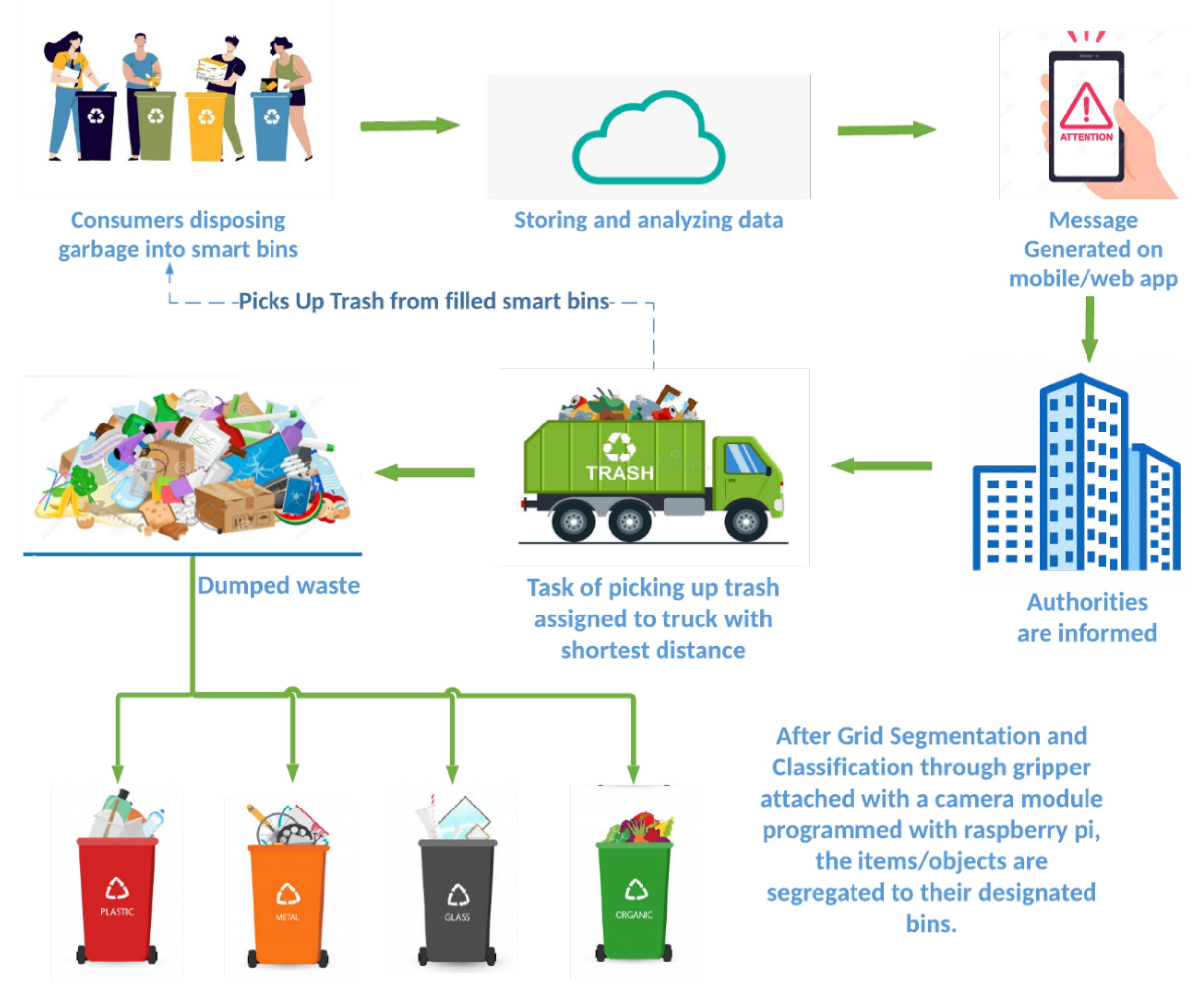
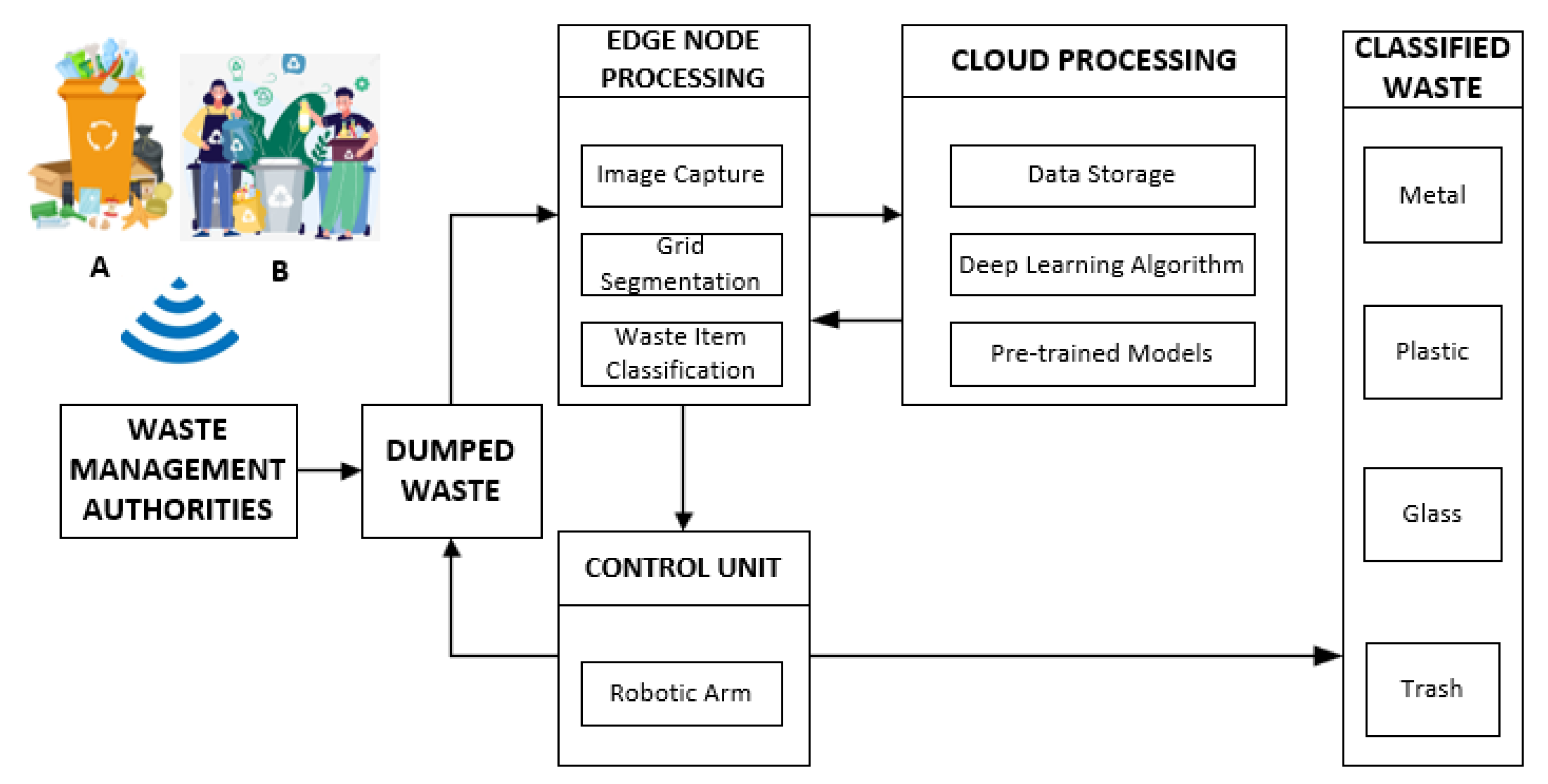
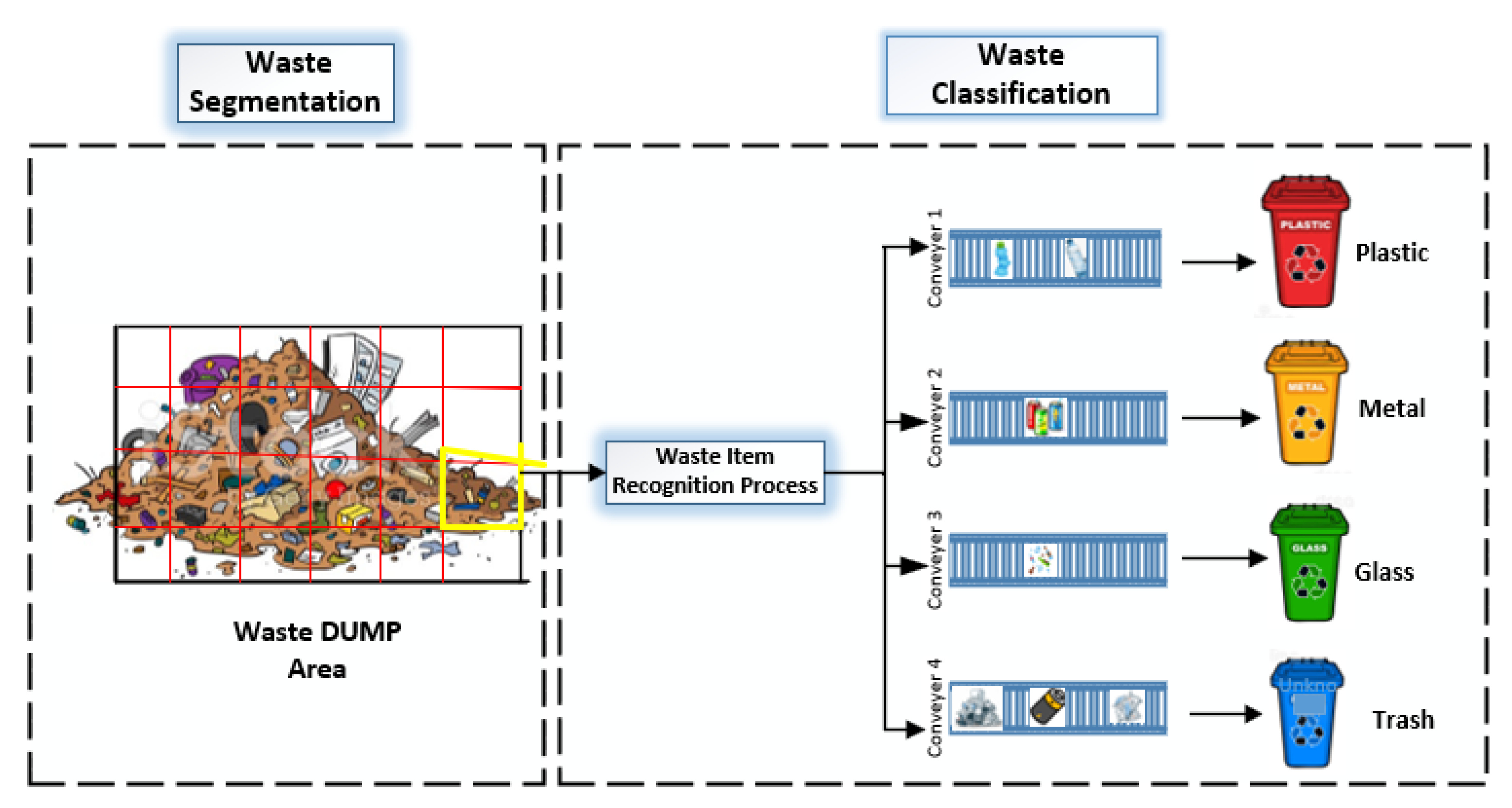


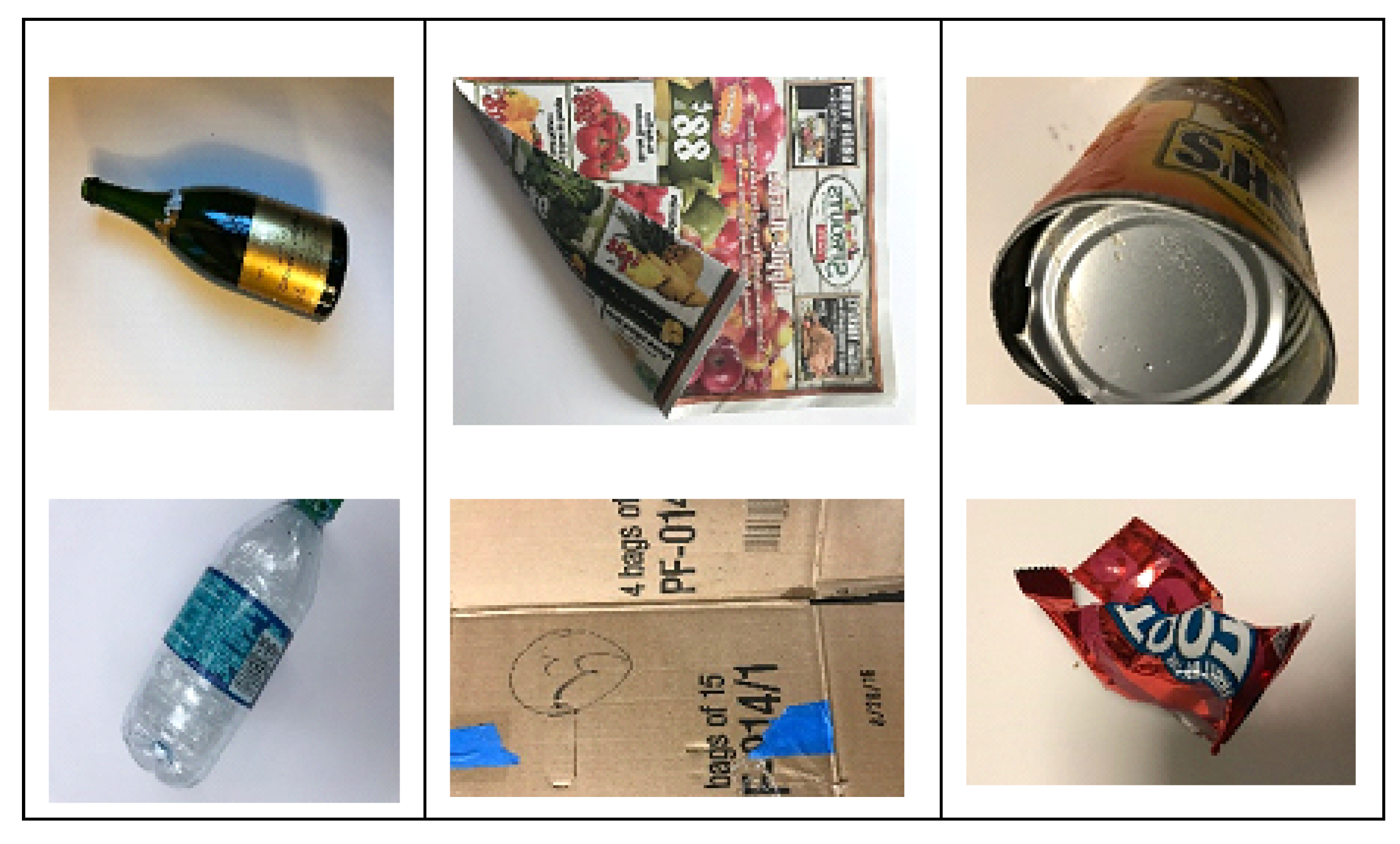
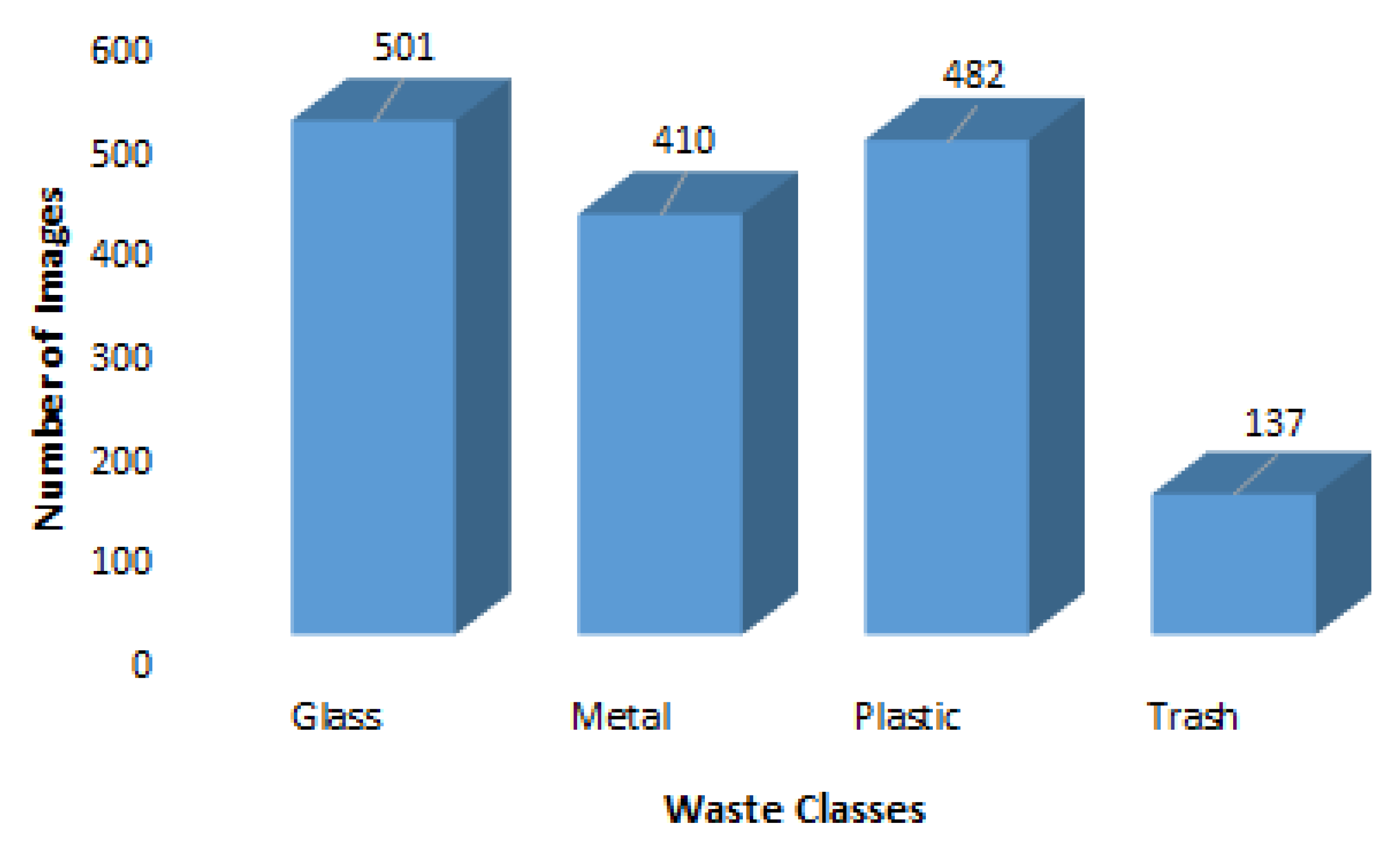
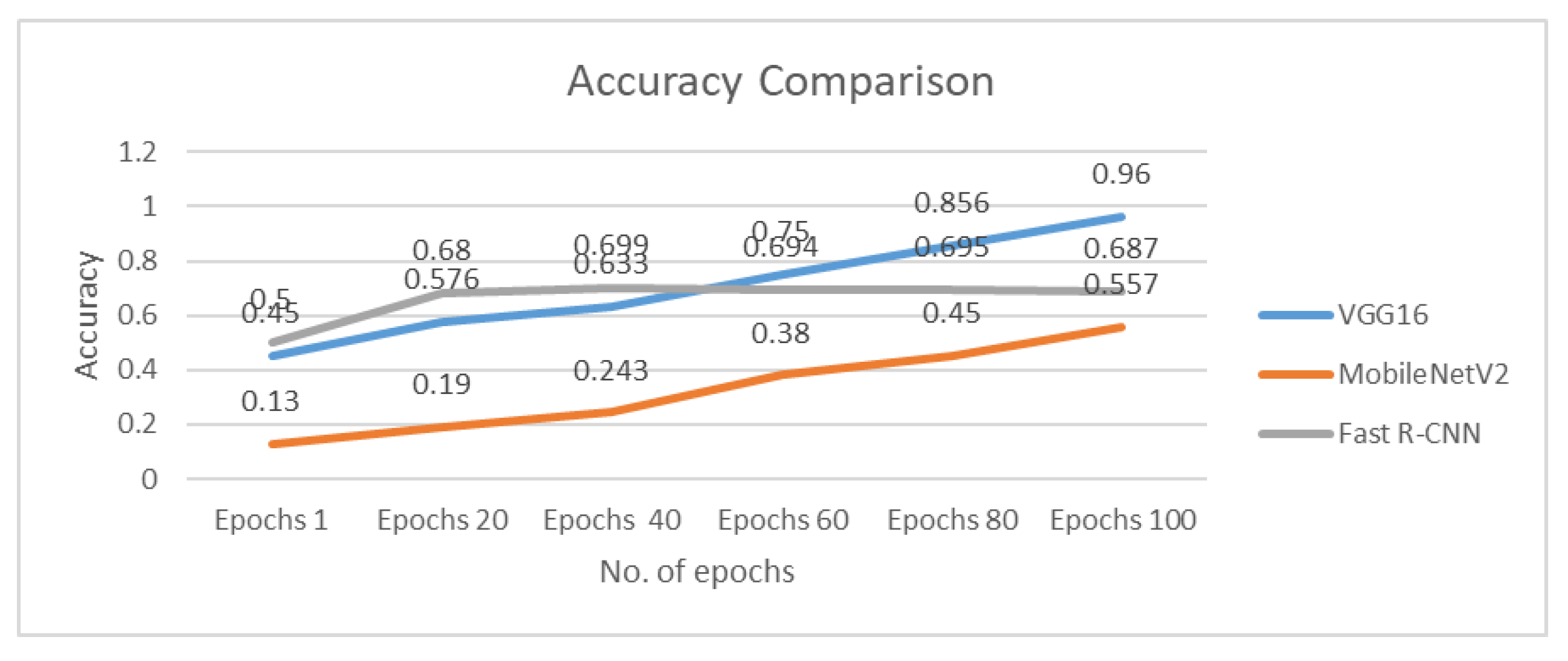
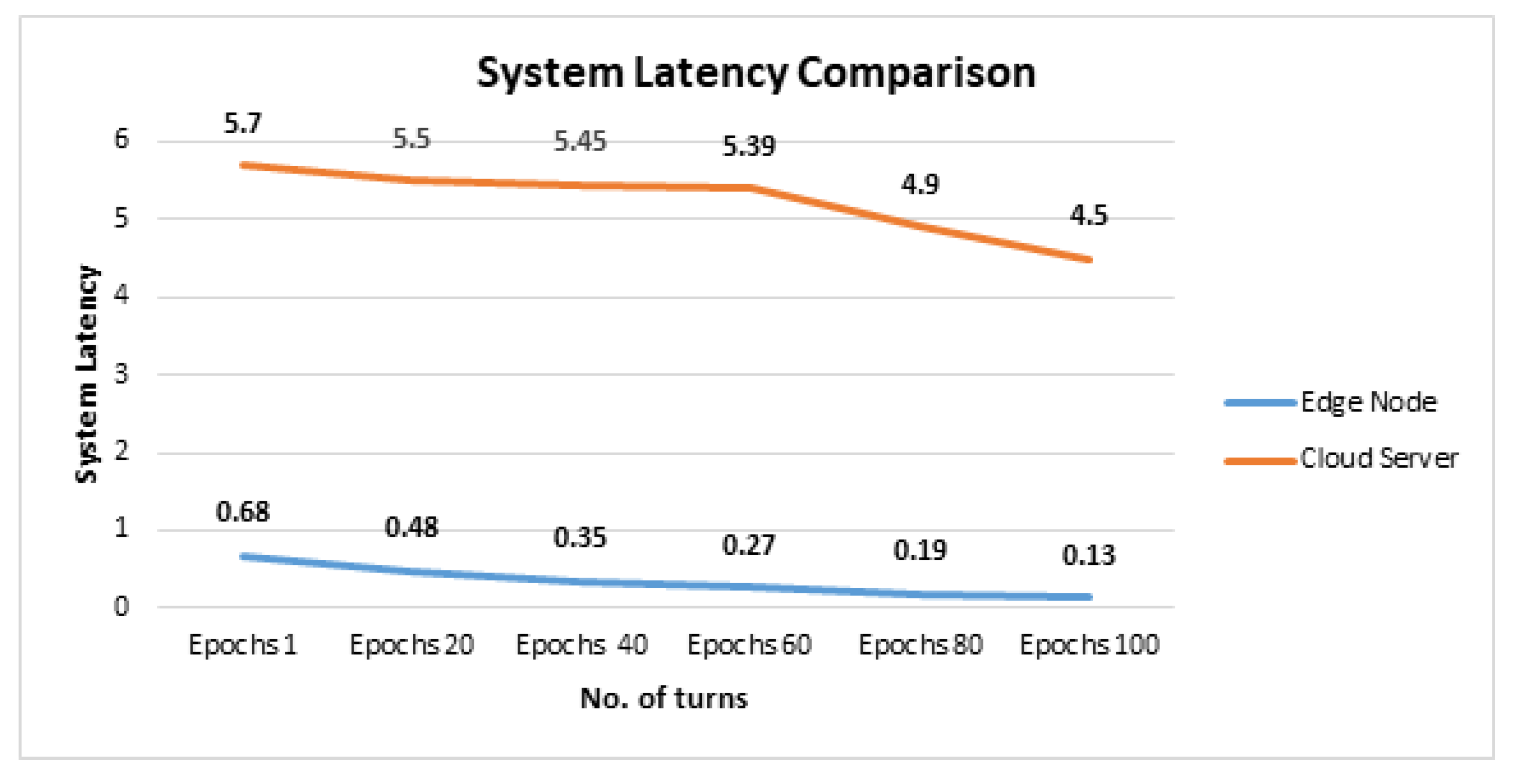
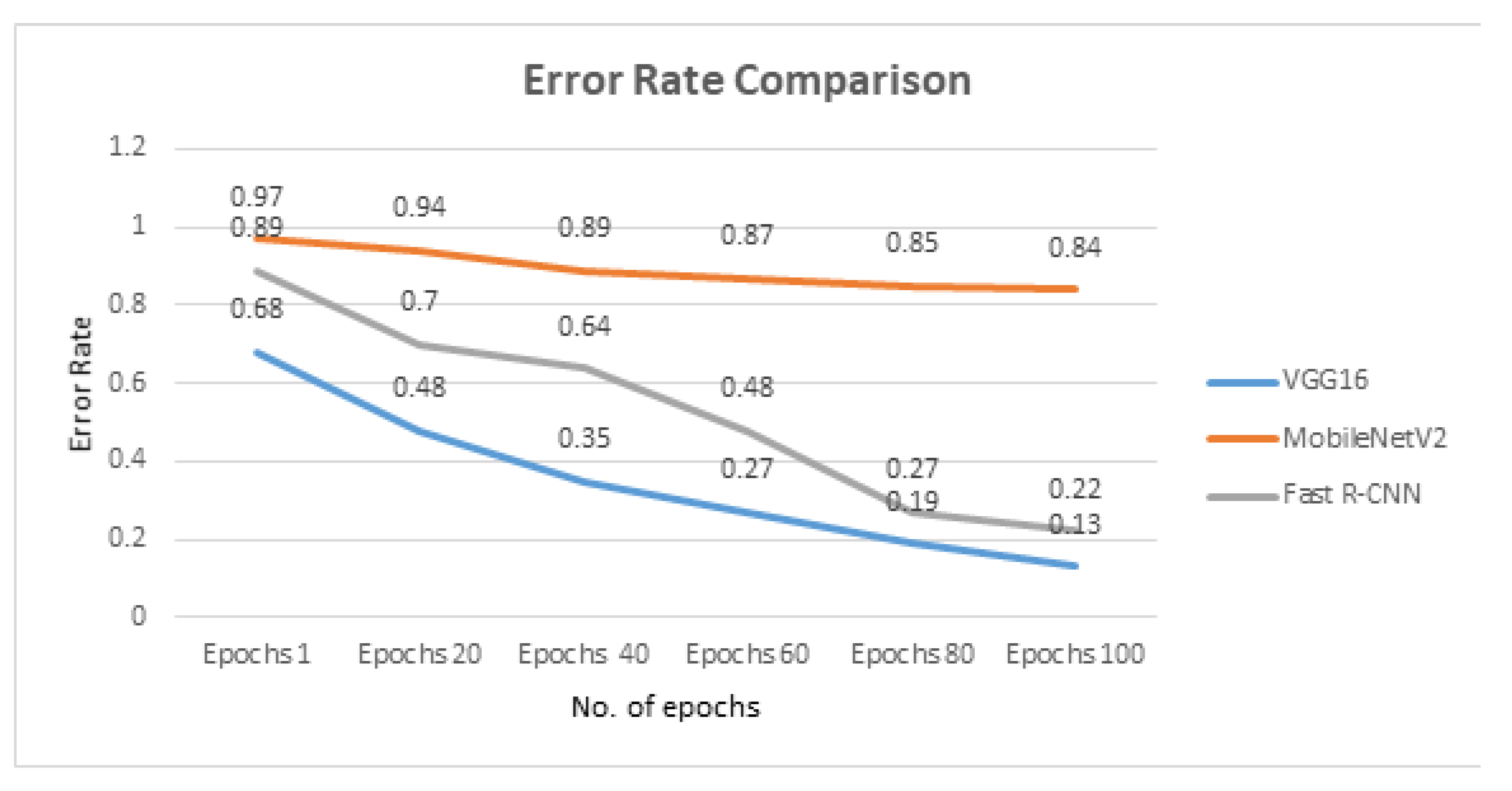

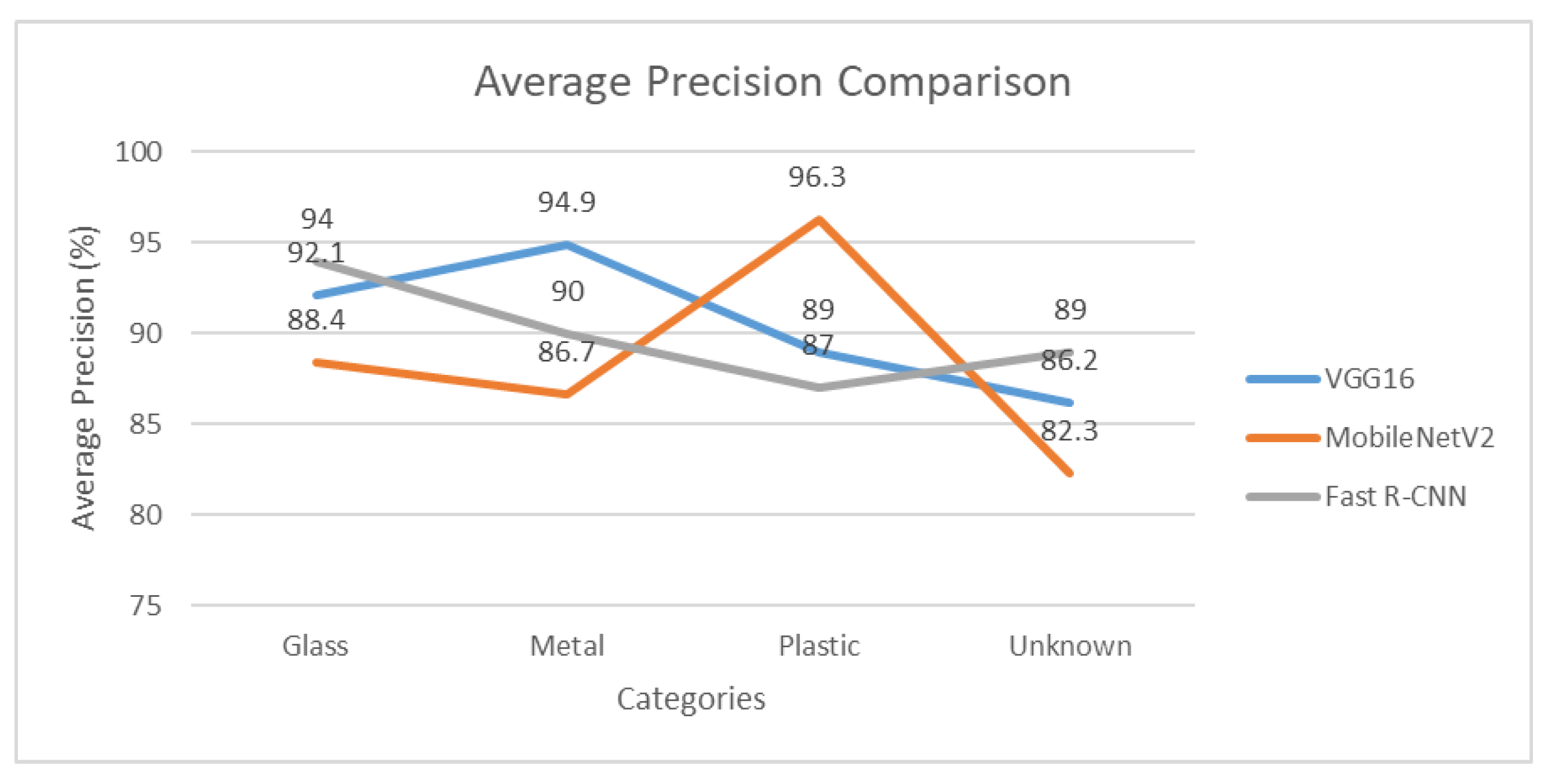

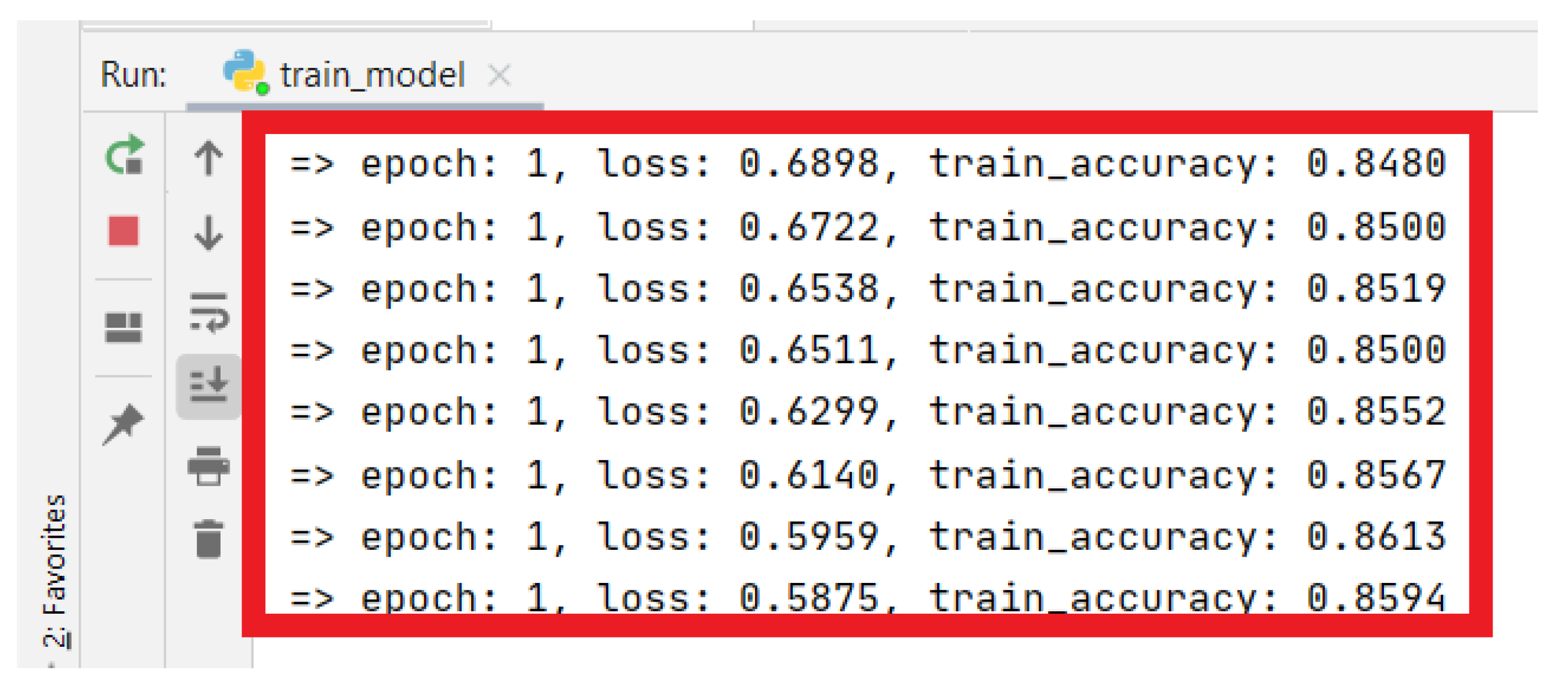

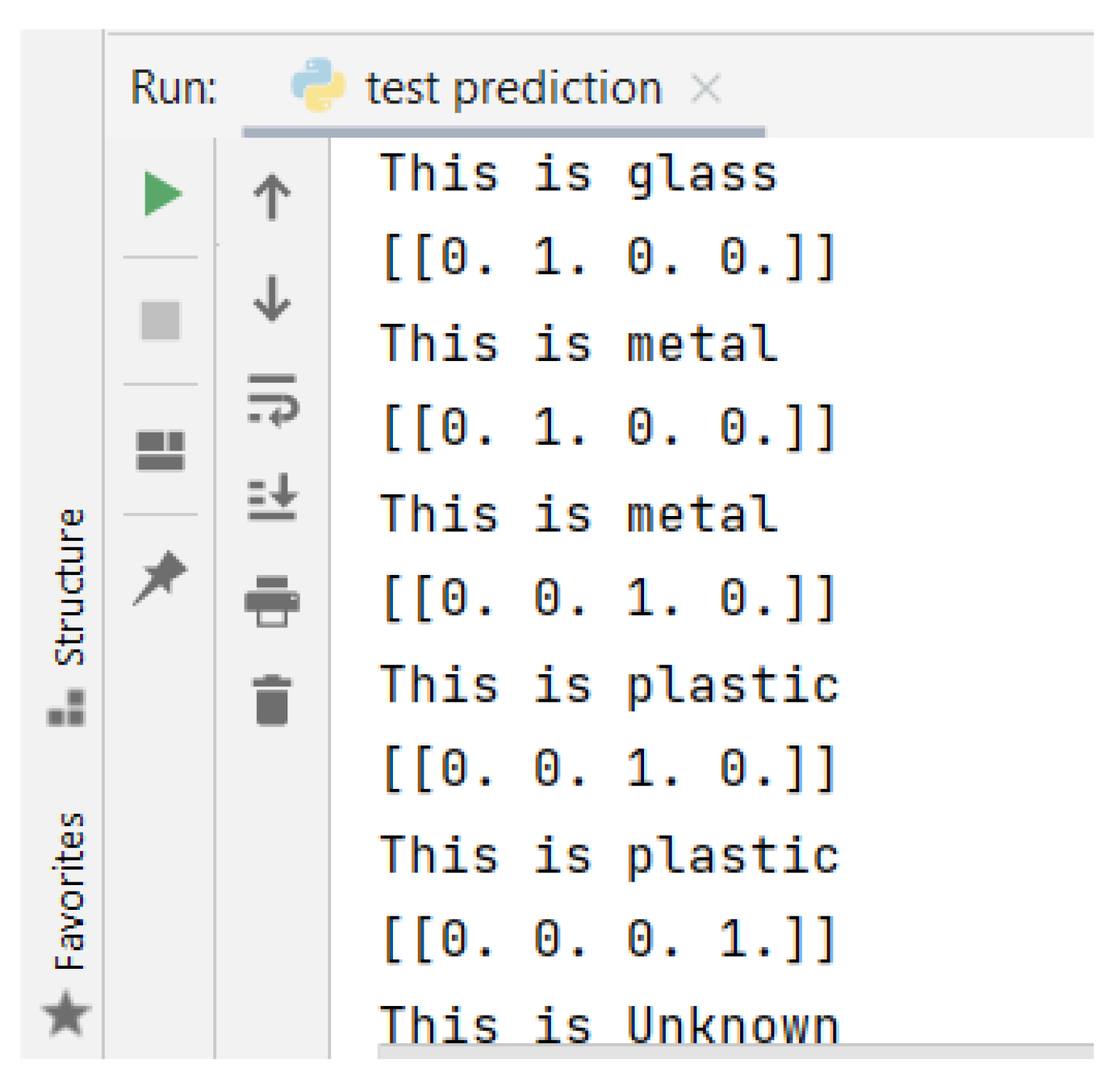
| Study | Architecture | For IoT | Waste Category | Hardware Category | Accuracy (%) | Dataset | Remarks |
|---|---|---|---|---|---|---|---|
| [74,75] | Multivariate analysis with neural network | NA | Light Weight Metals | Weight sensor, linear laser, 3D camera | 85% | NA | Cannot classify other materials |
| [76] | KNN | NA | Recyclable Paper | Camera | 93% | NA | Require consistent lightening during identification phase |
| [77] | Hu’s image invariant moments with KNN | NA | Inorganic material such as bottles, cutlery, Cans | Camera | 98% | NA | Unreliable results due to small dataset |
| [78] | DNA Computing Algorithms (RGBI) | NA | Paper | Camera | 95.1% | NA | Require consistent lightening during identification phase |
| [79] | SVM and CNN | NA | Paper, Metal and Plastic | Camera | SVM: 94.8% CNN: 83% | NA | Dataset is less versatile due to Low GPU memory images scaled down from 256 × 256 to 32 × 32 |
| [80] | Fast-R CNN | NA | Plastic Bottles | Robotic Arm, KUKA, Camera | 91% | NA | Segregate only plastic. Output reliant on lighting |
| [81] | Scale Invariant Feature Transform (SIFT) | NA | Organic and inorganic items with product labels | Camera | 89.9% | Self-made dataset of 192 images | Most waste items do not have product labels; hence, the scope is limited |
| Study | Architecture | For IoT | Waste Category | Hardware Category | Accuracy (%) | Dataset | Remarks |
|---|---|---|---|---|---|---|---|
| [52] | VGG16, CNN, ResNet50 | NA | Household food waste, recyclable waste, hazardous waste, residual waste | NA | VGG16: 37% CNN: 37% ResNet-50: 47% | Self-made | Not integrated with a decision support or classification system. Accuracy is not properly calculated |
| [82] | YOLOv3, Darknet neural network | NA | Glass, paper, metal, plastic, cardboard, organic waste | NA | Glass: 97% paper: 85% metal: 99% plastic: 91% cardboard: 97% org-waste: 98% mAP: 94% | Self-made | Takes more time to detect an object. |
| [83] | WasNet, Lightweight neural network | NA | NA | Camera | ImageNet: 64.5% Garbage Classification: 82.5% TrashNet: 96.10% | ImageNet, Garbage Classification dataset, TrashNet | Implementation and results are unreliable. |
| [73] | SURF algo., KNN | Yes | Metal, Plastic | Ultrasonic sensor, Moister sensor, metal sensor, Camera | 95% | Self Made | Only one waste item can be put in dustbin at a time. If image of waste material captured in low light then results may vary. |
| [57] | CNN, Self-Learning Neural Network | NA | Plastic, Paper, Cardboard, Metal | NA | 76% | Trash Net | Less accuracy due to limited dataset. Not integrated with a decision support or classification system. |
| [84] | CNN, Image Processing Algo. | NA | Plastic and its four categorical: PS, PP, PE-HD, PET | Camera, Airjet | 74% | WaDaBa | Less effective as compared to other CNNs. |
| [62] | ResNet50, DenseNet169, VGG16, AlexNet | NA | Glass, paper, metal, plastic, cardboard, Trash | NA | ResNet50: 89.7% DenseNet169: 92.6% VGG16: 86.9% AlexNet: 83.7% | ImageNet | System misclassify ‘glass’. Not integrated with a decision support or classification system. |
| Module Name | Hardware Requirement | Component Specs |
|---|---|---|
| Edge Node | Raspberry Pi 4B Pi-CAM | 4GB (RAM) 5MP |
| Cloud Processing | Artificial Intelligence Module | — |
| Pre-trained Deep Learning Model | — | |
| Control Unit | Micro-controller Bluetooth Module Gripper Stepper Motor | Arduino Mega 2560 HC 05 (Slave Mode) 4 Degree of Freedom (DOF) 1.8 deg/step, 2.4 V |
| Power Source | DC Battery | 6V, 4.5AH |
| Class Label | Training | Testing | Total |
|---|---|---|---|
| Metal | 328 | 82 | 410 |
| Metal | 328 | 82 | 410 |
| Glass | 400 | 101 | 501 |
| Plastic | 385 | 97 | 482 |
| Trash | 109 | 28 | 137 |
| Total | 1222 | 308 | 1530 |
| Study | Architecture | Waste Category | Accuracy |
|---|---|---|---|
| [52] | VGG16, CNN, ResNet50 | Household food waste, recyclable waste, hazardous waste, residual waste | VGG16:37% CNN: 37% ResNet-50: 47% |
| [83] | WasNet, Lightweight neural network | Not Available | ImageNet: 64.5% Garbage classification: 82.5% TrashNet: 96.10% |
| [57] | CNN, Self-Learning Neural Network | Plastic, Paper, Cardboard, Metal | 76% |
| [84] | CNN, Image-Processing Algorithm | Plastic and its four categories PS, PP, PE-HD PET | 74% |
| [62] | ResNet, DenseNet VGG-16, AlexNet | Glass, paper metal, plastic cardboard, trash | ResNet: 89.7% DenseNet169: 92.6% VGG16: 86.9% AlexNet: 83.7% |
| Proposed | VGG-16, Fast R-CNN, MobileNetV2 | Glass, plastic metal, trash | VGG16: 96.1% Fast RCNN: 88% MobileNet V2: 85% |
Publisher’s Note: MDPI stays neutral with regard to jurisdictional claims in published maps and institutional affiliations. |
© 2022 by the authors. Licensee MDPI, Basel, Switzerland. This article is an open access article distributed under the terms and conditions of the Creative Commons Attribution (CC BY) license (https://creativecommons.org/licenses/by/4.0/).
Share and Cite
Cheema, S.M.; Hannan, A.; Pires, I.M. Smart Waste Management and Classification Systems Using Cutting Edge Approach. Sustainability 2022, 14, 10226. https://doi.org/10.3390/su141610226
Cheema SM, Hannan A, Pires IM. Smart Waste Management and Classification Systems Using Cutting Edge Approach. Sustainability. 2022; 14(16):10226. https://doi.org/10.3390/su141610226
Chicago/Turabian StyleCheema, Sehrish Munawar, Abdul Hannan, and Ivan Miguel Pires. 2022. "Smart Waste Management and Classification Systems Using Cutting Edge Approach" Sustainability 14, no. 16: 10226. https://doi.org/10.3390/su141610226
APA StyleCheema, S. M., Hannan, A., & Pires, I. M. (2022). Smart Waste Management and Classification Systems Using Cutting Edge Approach. Sustainability, 14(16), 10226. https://doi.org/10.3390/su141610226







